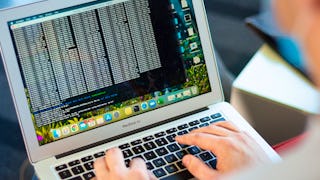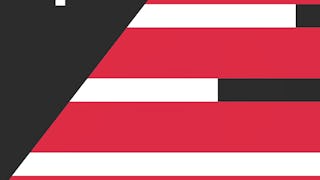Sind Sie bereit, in die Welt der Hardware und Betriebssysteme einzutauchen? In diesem einsteigerfreundlichen Kurs erwerben Sie wichtige Einstiegskompetenzen, die Sie für Tätigkeiten in den Bereichen IT-Support, Netzwerke, Cybersicherheit und Softwareentwicklung benötigen.

Genießen Sie unbegrenztes Wachstum mit einem Jahr Coursera Plus für 199 $ (regulär 399 $). Jetzt sparen.

Einführung in Hardware und Betriebssysteme
Dieser Kurs ist Teil mehrerer Programme.

Dozent: IBM Skills Network Team
90.042 bereits angemeldet
Bei enthalten
(2,027 Bewertungen)
Empfohlene Erfahrung
Was Sie lernen werden
Identifizierung der Hardwarekomponenten von Desktops, Laptops und anderen Geräten sowie der Funktionen des Betriebssystems, der Einstellungen und der Fehlerbehebungsverfahren
Untersuchen Sie Ports, Anschlüsse, Speichergeräte und GPU-Architekturen und bewerten Sie geeignete Verarbeitungs- und Hardwarelösungen für Anwendungen
Entwickeln Sie sichere IoT-Integrationsstrategien für tragbare Geräte und intelligente Technologien, indem Sie effektive Geräteverwaltung und Cybersicherheitsgrundsätze anwenden.
Bewertung von VR- und AR-Technologien für den Einsatz in Unternehmen unter Berücksichtigung von Hardwareanforderungen, Einsatzüberlegungen und praktischen Anwendungen.
Kompetenzen, die Sie erwerben
- Kategorie: Dateisysteme
- Kategorie: Netzwerk-Infrastruktur
- Kategorie: Software-Installation
- Kategorie: Linux
- Kategorie: Benutzerkonten
- Kategorie: Betriebssysteme
- Kategorie: Katastrophenhilfe
- Kategorie: Computer Hardware
- Kategorie: USB
- Kategorie: Computer Architektur
- Kategorie: System-Konfiguration
- Kategorie: Technische Unterstützung
- Kategorie: Mac OS
- Kategorie: Peripheriegeräte
- Kategorie: Hardware-Fehlerbehebung
- Kategorie: Virtualisierung und Virtuelle Maschinen
- Kategorie: Virtuelle Maschinen
- Kategorie: Computer-Systeme
- Kategorie: Computer-Bildschirme
- Kategorie: Datenspeicherung
Wichtige Details

Zu Ihrem LinkedIn-Profil hinzufügen
12 Aufgaben
Erfahren Sie, wie Mitarbeiter führender Unternehmen gefragte Kompetenzen erwerben.

Erweitern Sie Ihre Fachkenntnisse
- Lernen Sie neue Konzepte von Branchenexperten
- Gewinnen Sie ein Grundverständnis bestimmter Themen oder Tools
- Erwerben Sie berufsrelevante Kompetenzen durch praktische Projekte
- Erwerben Sie ein Berufszertifikat zur Vorlage

In diesem Kurs gibt es 7 Module
Willkommen zu Ihrem ersten Modul! Nach Abschluss dieses Moduls werden Sie in der Lage sein zu definieren, was ein Computer ist. Sie werden die vier Funktionen des Computers kennenlernen, die Teile eines Computers, die mit jeder dieser Funktionen verbunden sind, und die Vorteile des Computers. Sie erfahren, wie man Computergeräte nach Größe und Verwendungszweck klassifiziert, und beschreiben die Entwicklung von Betriebssystemen. Entdecken Sie, wie Computer mit Hilfe von Notationssystemen (Zahlen) kommunizieren, um Daten zu verarbeiten und zu speichern, Text auf dem Bildschirm anzuzeigen, Hardwareadressen, Website-Farben und Webadressen. Außerdem lernen Sie die Prinzipien der Oktalnotation kennen, um Dateiberechtigungen zu lösen und Nummerierungsumwandlungen durchzuführen. Sie erwerben das praktische Wissen, das Sie benötigen, um Rechenleistung und Speicherplatz zu bewerten. Sie kennen die vier Möglichkeiten, sich bei Microsoft Windows anzumelden, können die Verwendung des Startmenüs, der Kacheln, der Taskleiste und der Einstellungsmöglichkeiten beschreiben und sind in der Lage, die Verwaltung von Windows auf dem Desktop zu erklären. Abgerundet wird die Woche durch ein Labor, in dem Sie Programme finden und durch Windows navigieren, um wichtige Informationen über den Computer und das Betriebssystem Windows zu finden.
Das ist alles enthalten
7 Videos2 Lektüren2 Aufgaben1 App-Element1 Diskussionsthema1 Plug-in
Computer-Hardware ist die Gesamtheit der physischen Teile, aus denen das Innere Ihres Computers besteht. Peripheriegeräte sind Hardwareteile, die an der Außenseite eines Computers angebracht werden, damit dieser effizienter arbeiten kann. Sowohl Hardware als auch Peripheriegeräte werden verwendet, um Eingaben entgegenzunehmen, Daten zu speichern, Ausgaben anzuzeigen und Befehle auszuführen. In dieser Woche werden Sie verschiedene Arten von Hardwarekomponenten und Peripheriegeräten kennen lernen. Sie werden etwas über Drucker und Scanner, Eingabe-/Ausgabegeräte, externe Speichergeräte sowie Audio- und Videogeräte erfahren. Sie erhalten Einblicke in das Ökosystem des Internet der Dinge (IoT), einschließlich vernetzter Geräte, tragbarer Technologie und der Integration intelligenter Geräte. Spezialisierte Geräte wie E-Reader und ihre einzigartigen Display-Technologien werden besonders berücksichtigt.
Das ist alles enthalten
8 Videos1 Lektüre2 Aufgaben3 App-Elemente2 Plug-ins
Die zahlreichen internen und externen Komponenten eines Computers stehen in ständiger Wechselwirkung miteinander, um Eingaben zu empfangen, angeforderte Rechenfunktionen auszuführen und Ausgaben zu tätigen. Da sich die Technologie weiterentwickelt hat und die Verbindungsmethoden standardisiert wurden, kann nun eine große Anzahl externer Geräte einfach und erfolgreich mit Computern verbunden werden und ihre Aufgaben zuverlässig erfüllen. In dieser Woche werden Sie lernen, wie Hardware und Peripheriegeräte miteinander verbunden werden, um einen funktionierenden Computer zu bilden. Sie lernen Ports, Schnittstellen und Anschlüsse kennen, die von Grafik-, Audio-, Netzwerk-, Drucker- und anderen Peripheriegeräten verwendet werden. Sie werden auch die Arten von Installationen kennen lernen, die diese Geräte benötigen, um betriebsbereit zu sein. Darüber hinaus werden Sie Grafikprozessoren (GPUs) untersuchen, von Grafikhardware bis hin zu Parallelprozessoren, die Spiele, KI und wissenschaftliche Berechnungen antreiben. Das Modul befasst sich auch mit Virtual Reality (VR)- und Augmented Reality (AR)-Technologien, wobei der Schwerpunkt auf praktischem IT-Management, Sicherheitsprotokollen und Überlegungen zur Implementierung liegt.
Das ist alles enthalten
8 Videos1 Lektüre2 Aufgaben2 App-Elemente1 Plug-in
Computer-Hardware, der physische Teil eines Computers, wird nur selten geändert, während Software und Daten häufig modifiziert werden. Wenn Sie an Computer-Hardware denken, denken Sie wahrscheinlich an das, was sich in Ihrem Computer zu Hause oder in Ihrem Computer am Arbeitsplatz befindet. Der Begriff Computer-Hardware bezieht sich jedoch nicht speziell auf Personal Computer. Es handelt sich vielmehr um alle Arten von Computersystemen. Computerhardware befindet sich in eingebetteten Systemen in Autos, Mikrowellenherden, CD-Playern, DVD-Playern und vielen anderen Geräten. In dieser Lektion lernen Sie die üblichen internen Komponenten von Computersystemen für den privaten und geschäftlichen Gebrauch kennen.
Das ist alles enthalten
6 Videos1 Lektüre2 Aufgaben2 App-Elemente1 Plug-in
Die Einrichtung von Workstations, die Konfiguration von Betriebssystemen und die Fehlerbehebung bei Workstations gehören zum Tagesgeschäft des IT-Supports. Ganz gleich, ob es darum geht, einen neuen Computer für einen Kollegen auszuwählen, ein Betriebssystem neu zu konfigurieren, damit ein Mitarbeiter barrierefrei arbeiten kann, oder ein Problem mit der Sichtbarkeit von Dateien oder Verzeichnissen zu beheben - IT-Support-Mitarbeiter brauchen Verfahren, die ihnen helfen, diese Aufgaben schnell, sicher und korrekt zu erledigen. In dieser Woche erwerben Sie Kenntnisse über die Beschaffung von Arbeitsplätzen und die grundlegende Konfiguration und Verwaltung von Windows-Betriebssystemen. Sie lernen Techniken kennen, mit denen Sie die Organisation von Dateien und Ordnern optimieren und vielleicht sogar Benutzern helfen können, versteckte Dateien zu finden. Sie lernen zeitsparende Tastaturbefehle zur Erfassung von Bildschirmen mit Windows 10 Workstations, macOS Workstations und Chromebooks. Sie vervollständigen Ihr Wissen mit einem Überblick über die Prinzipien der Business Continuity, die für Fehlertoleranz und Disaster Recovery verwendet werden.
Das ist alles enthalten
10 Videos1 Lektüre3 Aufgaben2 App-Elemente3 Plug-ins
In diesem Modul werden Sie Ihr Kurswissen anhand eines abschließenden Quiz überprüfen, das auf den vorangegangenen fünf Modulen basiert.
Das ist alles enthalten
2 Videos2 Lektüren1 Aufgabe1 App-Element2 Plug-ins
Willkommen zu Ihrem Bonusmodul! Obwohl Microsoft Windows den Markt für Desktop-Betriebssysteme dominiert, verwenden Unternehmen auch Computer mit den Betriebssystemen Linux, macOS und ChromeOS. Und viele Unternehmen unterstützen auch Benutzer, die Geräte mit den mobilen Betriebssystemen iOS und Android besitzen. Nach Abschluss dieses Moduls werden Sie in der Lage sein zu erklären, warum Unternehmen diese alternativen Betriebssysteme unterstützen. Sie werden in der Lage sein, die Anmeldeprozesse von Betriebssystemen, Netzwerkverbindungsmethoden, Bildschirmnavigation, Menüs und Funktionen zu vergleichen und gegenüberzustellen. Dieses Modul befasst sich mit grundlegenden Computerkonzepten und neuen Technologien, die moderne IT-Umgebungen definieren. Die Erforschung der Virtualisierungstechnologie umfasst Host/Gast-Betriebssysteme und Hypervisor-Implementierungen. Sie werden auch das nötige Wissen erwerben, um zu erklären, wo jedes Betriebssystem Gerätekennungen, Versionsinformationen und Systemeinstellungen speichert. Erweitern und vertiefen Sie Ihre Linux-Kenntnisse im Linux-Labor.
Das ist alles enthalten
7 Videos1 Lektüre1 App-Element1 Plug-in
Erwerben Sie ein Karrierezertifikat.
Fügen Sie dieses Zeugnis Ihrem LinkedIn-Profil, Lebenslauf oder CV hinzu. Teilen Sie sie in Social Media und in Ihrer Leistungsbeurteilung.
Dozent

von
Mehr von Unterstützung und Betrieb entdecken
 Status: Vorschau
Status: Vorschau Status: Vorschau
Status: Vorschau Status: Kostenloser Testzeitraum
Status: Kostenloser TestzeitraumMicrosoft
 Status: Kostenloser Testzeitraum
Status: Kostenloser Testzeitraum
Warum entscheiden sich Menschen für Coursera für ihre Karriere?




Bewertungen von Lernenden
2.027 Bewertungen
- 5 stars
76,76 %
- 4 stars
18,40 %
- 3 stars
3,10 %
- 2 stars
0,74 %
- 1 star
0,98 %
Zeigt 3 von 2027 an
Geprüft am 12. Juni 2025
This course is helped my accademics. I improved hardware and operating system knowledge. simulator desktop is more valuable for understand better. It gave prictically background as well.
Geprüft am 16. Juli 2022
very well organized, and I liked that videos were short but numerous enough to articulate the different facets individually
Geprüft am 12. Sep. 2024
I learn many things from this course and according to me this course material were too good to understand about the hardware and operating systems
Häufig gestellte Fragen
Um Zugang zu den Kursmaterialien und Aufgaben zu erhalten und um ein Zertifikat zu erwerben, müssen Sie die Zertifikatserfahrung erwerben, wenn Sie sich für einen Kurs anmelden. Sie können stattdessen eine kostenlose Testversion ausprobieren oder finanzielle Unterstützung beantragen. Der Kurs kann stattdessen die Option "Vollständiger Kurs, kein Zertifikat" anbieten. Mit dieser Option können Sie alle Kursmaterialien einsehen, die erforderlichen Bewertungen abgeben und eine Abschlussnote erhalten. Dies bedeutet auch, dass Sie kein Zertifikat erwerben können.
Wenn Sie sich für den Kurs anmelden, erhalten Sie Zugang zu allen Kursen des Zertifikats, und Sie erhalten ein Zertifikat, wenn Sie die Arbeit abgeschlossen haben. Ihr elektronisches Zertifikat wird zu Ihrer Seite "Leistungen" hinzugefügt - von dort aus können Sie Ihr Zertifikat ausdrucken oder zu Ihrem LinkedIn-Profil hinzufügen.
Weitere Fragen
Finanzielle Unterstützung verfügbar,





